-
MyBatis使用注解操作及XML操作
1. 注解操作
MyBatis的操作分为注解和XML操作两种, 上篇博客介绍了MyBatis配置和简单操作,最后也进行了查询,而那种查询操作就是使用注解的方式。
这篇博客和上一篇具有一定关联性,
可以点击上一篇跳转。
下面介绍更多的操作。1.1 打印日志
在Mybatis当中我们可以借助⽇志, 查看到sql语句的执⾏、执⾏传递的参数以及执⾏结果。
配置代码如下:mybatis: configuration: # 打印日志 log-impl: org.apache.ibatis.logging.stdout.StdOutImpl- 1
- 2
- 3
- 4
配置完执行结果就会带有SQL执行内容:
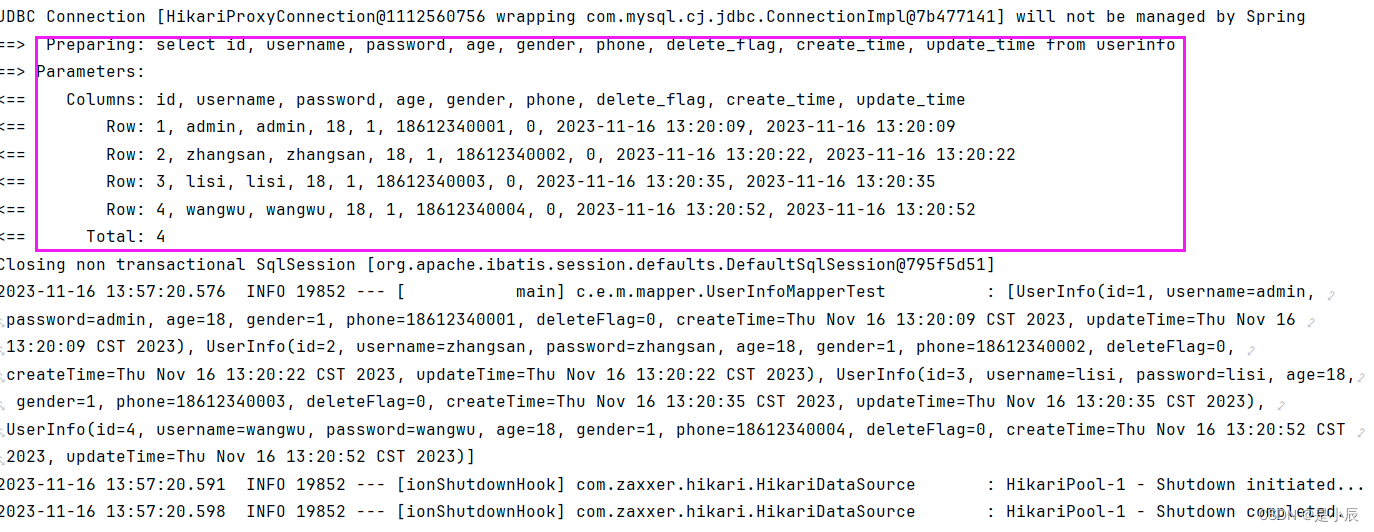
1.2 参数传递
如果我们查询一个id为4的用户,可以直接查询。

运行测试方法:


会得到了想要的结果。
但是,可以发现一种弊端,这种方法是写死的,难道又想获得id为其他的用户,还写许多的方法吗?
答案是不用,可以通过#{…}使用参数传递的方式进行解决。

这样,当不管查询任意id的用户,只需要传递不同参数即可,不需要修改方法中的代码。
注意:- 如果参数只有一个,那么#{}中的名字可以随便写,idea会自己识别。一般还是相同最好。
- 如果参数为多个,#{}中的名字要和方法参数名字一一对应。
也可以通过 @Param , 设置参数的别名, 如果使⽤ Param 设置别名, #{…}⾥⾯的属性名必须和@Param 设置的⼀样。

1.3 增(Insert)
增加使用Insert注解,使用规则和Select相同。但是查询必须要接受返回值,而插入可以没有返回值,也可以有。这里模仿MySql中返回整型,表示影响的行数。
代码:
@Insert("insert into userinfo(username,password,age,gender,phone) " + "values(#{username},#{password},#{age},#{gender},#{phone})") Integer insert(UserInfo userInfo);- 1
- 2
- 3
测试代码:
@Test void insert() { UserInfo userInfo = new UserInfo(); userInfo.setUsername("aaa"); userInfo.setPassword("aaa"); userInfo.setAge(18); userInfo.setGender(1); userInfo.setPhone("12345678"); Integer result = userInfoMapper.insert(userInfo); log.info("insert 方法, 执行结果: {}",result); }- 1
- 2
- 3
- 4
- 5
- 6
- 7
- 8
- 9
- 10
- 11
运行结果:

查询数据库:

注意1:重命名
这里需要注意,如果使用重命名,传递参数为对象,重命名后,获得对象方式需要修改,使用参数.属性 来获取。

注意2:返回主键
Insert 语句默认返回的是 受影响的⾏数,但有些情况下, 数据插⼊之后, 还需要有后续的关联操作, 需要获取到新插⼊数据的id。
如果想要拿到⾃增id, 需要在Mapper接⼝的⽅法上添加⼀个Options的注解。@Options(useGeneratedKeys = true, keyProperty = "id") @Insert("insert into userinfo(username,password,age,gender,phone) " + "values(#{username},#{password},#{age},#{gender},#{phone})") Integer insert(UserInfo userInfo);- 1
- 2
- 3
- 4
useGeneratedKeys:这会令 MyBatis 使⽤ JDBC 的 getGeneratedKeys ⽅法来取出由数据库内部⽣成的主键(⽐如:像 MySQL 和 SQL Server 这样的关系型数据库管理系统的⾃动递增字段),默认值:false。
keyProperty:指定能够唯⼀识别对象的属性,MyBatis 会使⽤ getGeneratedKeys 的返回值或insert 语句的 selectKey ⼦元素设置它的值,默认值:未设置(unset)。测试代码:
@Test void insert() { UserInfo userInfo = new UserInfo(); userInfo.setUsername("aaa"); userInfo.setPassword("aaa"); userInfo.setAge(18); userInfo.setGender(1); userInfo.setPhone("12345678"); Integer result = userInfoMapper.insert(userInfo); log.info("insert 方法, 执行结果: {}, 自增主键ID: {}",result,userInfo.getId()); }- 1
- 2
- 3
- 4
- 5
- 6
- 7
- 8
- 9
- 10
- 11

1.4 删(Delete)
删使用Delete注解。
代码:
@Delete("delete from userinfo where id = #{id}") Integer delete(Integer id);- 1
- 2
测试代码:
@Test void delete() { Integer id = 5; Integer result = userInfoMapper.delete(id); log.info("delete方法, 执行结果: {}",result); }- 1
- 2
- 3
- 4
- 5
- 6
运行结果:

数据库:

1.5 改(Update)
改使用Update注解。
@Update("update userinfo set age = #{age} where id = #{id}") Integer update(UserInfo userInfo);- 1
- 2
测试代码:
@Test void update() { UserInfo userInfo = new UserInfo(); userInfo.setId(4); userInfo.setAge(19); Integer result = userInfoMapper.update(userInfo); if(result > 0){ log.info("方法执行成功"); } }- 1
- 2
- 3
- 4
- 5
- 6
- 7
- 8
- 9
- 10
运行结果:

数据库:
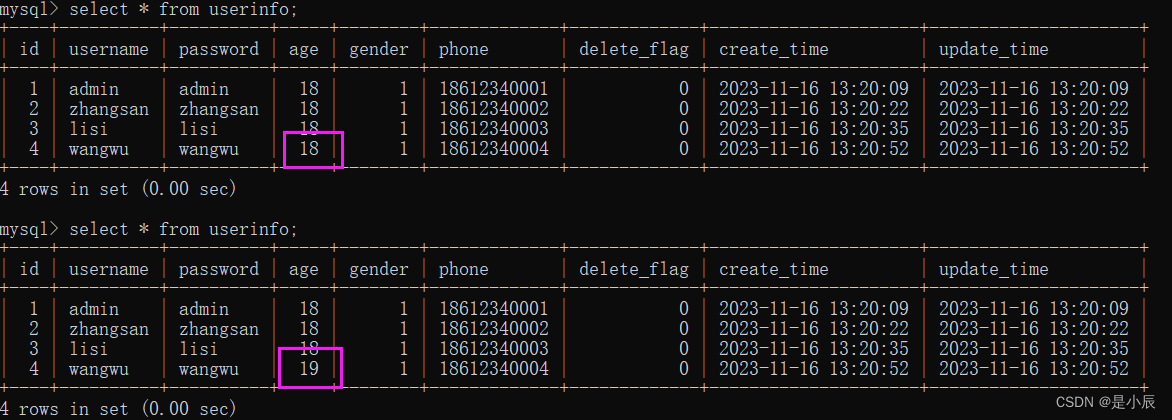
1.6 查(Select)
正常查时,只有Java对象属性和数据库字段⼀模⼀样时, 才会进
⾏赋值。
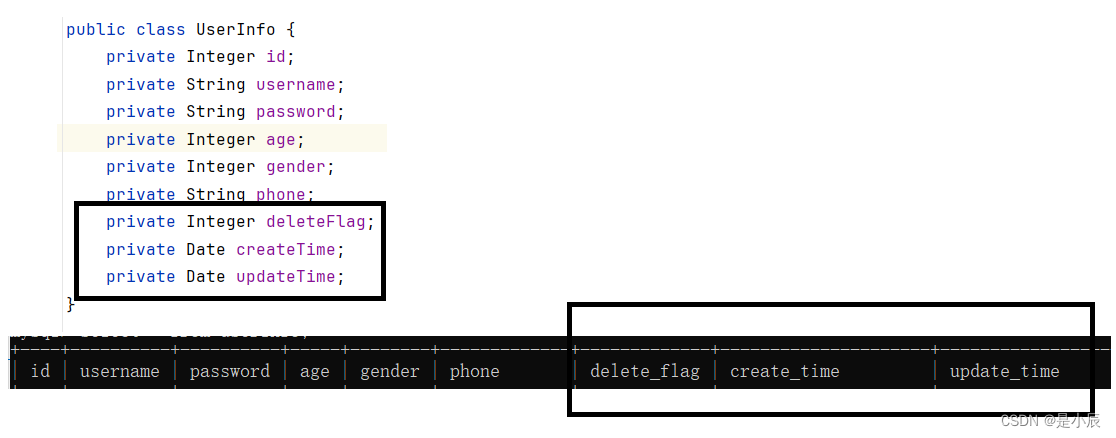
而前面查时,后面三个并不相同,但是还是成功赋值了,这是为什么呢?
1. 配置,开启驼峰命名
其实是因为通常数据库列使⽤蛇形命名法进⾏命名(下划线分割各个单词), ⽽ Java 属性⼀般遵循驼峰命名法约定。我们可以进行配置使这两种命名⽅式之间启⽤⾃动映射。
mybatis: configuration: # 自动转驼峰 map-underscore-to-camel-case: true- 1
- 2
- 3
- 4
2. 起别名
@Select("select id, username, password, age, gender, phone," + " delete_flag as deleteFlag, create_time as createTime, update_time as updateTime" + " from userinfo") List<UserInfo> queryAllUser();- 1
- 2
- 3
- 4
这样也可以解决问题,但是没有直接配置简单,推荐还是配置。
3. 使用注解
除了上面两种,还可以使用Results注解。
使用规则:@Results(id = "BaseMap",value = { @Result(column = "delete_flag", property = "deleteFlag"), @Result(column = "create_time", property = "createTime"), @Result(column = "update_time", property = "updateTime") }) @Select("select id, username, password, age, gender, phone," + " delete_flag, create_time, update_time" + " from userinfo") List<UserInfo> queryAllUser();- 1
- 2
- 3
- 4
- 5
- 6
- 7
- 8
- 9
column是数据库字段,property是Java对象属性。
起个id方便其他方法使用,如图:
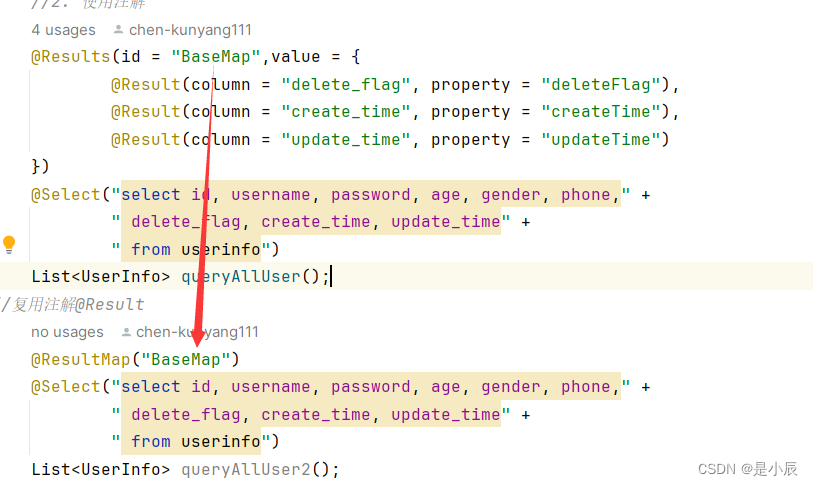
后面在使用,通过ResultMap注解加id即可。
如果使用这种方法,既然转换了,记得全部字段属性转换。2. XML操作
MyBatis的开发有两种方式,上面的注解是其中一种,它主要适合简单的增删查改功能。它要实现一些复杂的SQL的功能,就会非常的麻烦,所有还有另一种开发方式,XML。
Mybatis XML操作方式需要下面两步:- 配置数据库连接字符串和Mybatis。
- 写持久层代码。
2.1 配置数据库连接字符串和Mybatis
此步骤需要进⾏两项设置,数据库连接字符串设置和 MyBatis 的 XML ⽂件配置。
如果是application.yml⽂件, 配置内容如下:spring: datasource: url: jdbc:mysql://127.0.0.1:3306/mybatis_test?characterEncoding=utf8&useSSL=false username: root password: 131452 driver-class-name: com.mysql.cj.jdbc.Driver mybatis: # XML开发 mapper-locations: classpath:mapper/*Mapper.xml- 1
- 2
- 3
- 4
- 5
- 6
- 7
- 8
- 9
- 10
- 11
2.2 写持久层代码
持久层代码分两部分
- ⽅法定义 Interface
- ⽅法实现: XXX.xml

1. 添加mapper接口
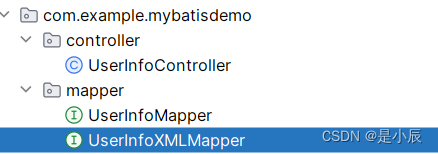
代码:package com.example.mybatisdemo.mapper; import com.example.mybatisdemo.model.UserInfo; import org.apache.ibatis.annotations.Mapper; import java.util.List; @Mapper public interface UserInfoXMLMapper { List<UserInfo> selectAllUser(); }- 1
- 2
- 3
- 4
- 5
- 6
- 7
- 8
- 9
- 10
- 11
2. 添加 UserInfoXMLMapper.xml
创建UserInfoXMLMapper.xml文件,mapper包,**Mapper.xml。

添加固定的配置代码:DOCTYPE mapper PUBLIC "-//mybatis.org//DTD Mapper 3.0//EN" "http://mybatis.org/dtd/mybatis-3-mapper.dtd"> <mapper namespace="com.example.mybatisdemo.mapper.UserInfoXMLMapper"> mapper>- 1
- 2
- 3
- 4
- 5
对应关系:

3. 简单实现查
代码如下:
DOCTYPE mapper PUBLIC "-//mybatis.org//DTD Mapper 3.0//EN" "http://mybatis.org/dtd/mybatis-3-mapper.dtd"> <mapper namespace="com.example.mybatisdemo.mapper.UserInfoXMLMapper"> <select id="selectAllUser" resultType="com.example.mybatisdemo.model.UserInfo"> select username, password, age, gender, phone from userinfo select> mapper>- 1
- 2
- 3
- 4
- 5
- 6
- 7
对应关系如下:
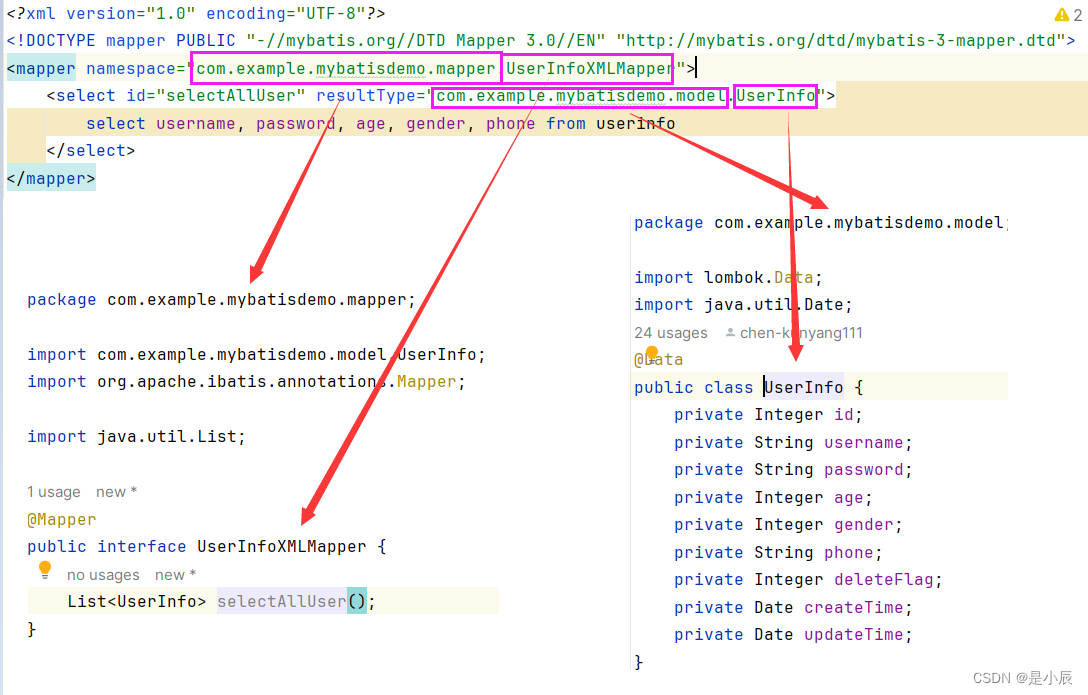
< mapper> 标签:需要指定 namespace 属性,表⽰命名空间,值为 mapper 接⼝的全限定名,包括全包名.类名。
< select >标签 :是⽤来执⾏数据库的查询操作的:
id :是和 Interface (接⼝)中定义的⽅法名称⼀样的,表⽰对接⼝的具体实现⽅法。
resultType :是返回的数据类型,也就是开头我们定义的实体类。2.3 单元测试
Alt+Insert自动生成测试类:
填写代码:package com.example.mybatisdemo.mapper; import com.example.mybatisdemo.model.UserInfo; import lombok.extern.slf4j.Slf4j; import org.junit.jupiter.api.Test; import org.springframework.beans.factory.annotation.Autowired; import org.springframework.boot.test.context.SpringBootTest; import java.util.List; import static org.junit.jupiter.api.Assertions.*; @Slf4j @SpringBootTest class UserInfoXMLMapperTest { @Autowired private UserInfoXMLMapper userInfoXMLMapper; @Test void selectAllUser() { List<UserInfo> list = userInfoXMLMapper.selectAllUser(); log.info(list.toString()); } }- 1
- 2
- 3
- 4
- 5
- 6
- 7
- 8
- 9
- 10
- 11
- 12
- 13
- 14
- 15
- 16
- 17
- 18
- 19
- 20
- 21
- 22
运行结果:
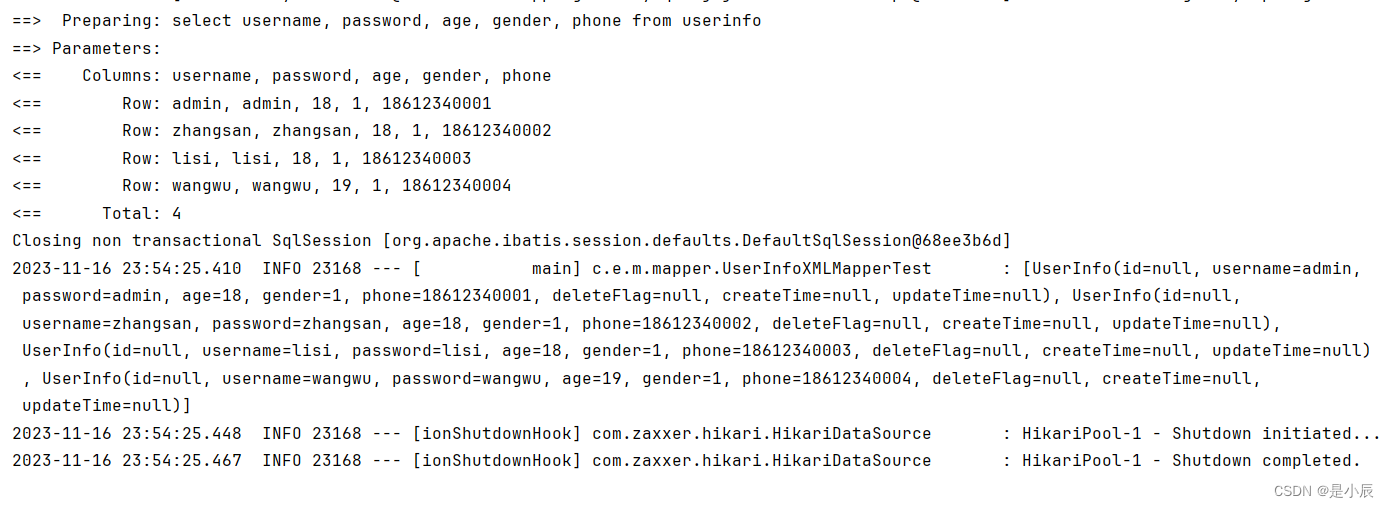
2.4 增删改查操作
1. 增(Insert)
接口:
Integer insertUser(UserInfo userInfo);- 1
xml:
<insert id="insertUser"> insert into userinfo (username, password, age, gender, phone) value(#{username}, #{password}, #{age},#{gender},#{phone}) insert>- 1
- 2
- 3
- 4
测试:
@Test void insertUser() { UserInfo userInfo = new UserInfo(); userInfo.setUsername("bbb"); userInfo.setPassword("bbb"); userInfo.setAge(20); userInfo.setGender(2); userInfo.setPhone("12312321"); Integer result = userInfoXMLMapper.insertUser(userInfo); log.info("执行影响行数: {}",result); }- 1
- 2
- 3
- 4
- 5
- 6
- 7
- 8
- 9
- 10
- 11
执行结果:

MySql:

注意1:重命名
使用@Param,规则和注解一样。
Integer insertUser(@Param("insertinfo") UserInfo userInfo);- 1
- 2
<insert id="insertUser"> insert into userinfo (username, password, age, gender, phone) value(#{insertinfo.username}, #{insertinfo.password}, #{insertinfo.age},#{insertinfo.gender},#{insertinfo.phone}) insert>- 1
- 2
- 3
- 4
注意2:返回主键
接⼝定义不变, Mapper.xml 实现 设置useGeneratedKeys 为true和keyProperty属性,属性为获取主键。
<insert id="insertUser"> useGeneratedKeys="true" keyProperty="id"> insert into userinfo (username, password, age, gender, phone) value(#{username}, #{password}, #{age},#{gender},#{phone}) insert>- 1
- 2
- 3
- 4
2. 删(Delete)
Integer deleteUser(Integer id);- 1
<delete id="deleteUser"> delete from userinfo where id = #{id} delete>- 1
- 2
- 3
3. 改(Update)
Integer updateUser(UserInfo userInfo);- 1
<update id="updateUser"> update userinfo set username=#{username} where id=#{id} update>- 1
- 2
- 3
4. 查(Select)
查时,如果表的字段和Java对象属性名不同,也不会赋值,结果方案有三种:
- 起别名
- 结果映射
- 开启驼峰命名
其中1,3的解决办法和注解⼀样,不再多说, 接下来看下xml如果来写结果映射。
<resultMap id="BaseMap" type="com.example.mybatisdemo.model.UserInfo"> <id column="id" property="id">id> <result column="delete_flag" property="deleteFlag">result> <result column="create_time" property="createTime">result> <result column="update_time" property="updateTime">result> resultMap> <select id="selectAllUser" resultMap="BaseMap" resultType="com.example.mybatisdemo.model.UserInfo"> select username, password, age, gender, phone from userinfo select>- 1
- 2
- 3
- 4
- 5
- 6
- 7
- 8
- 9
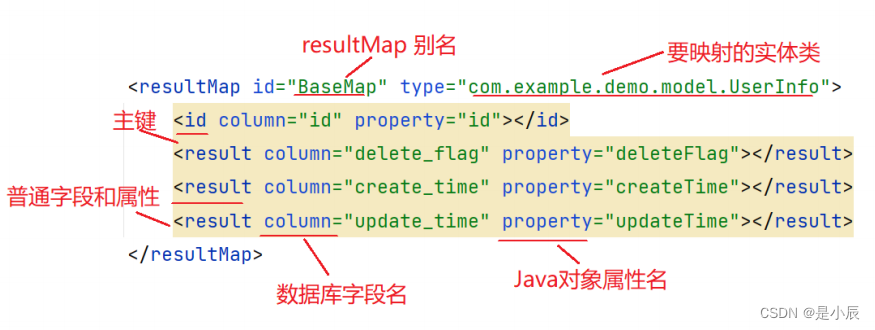
3. 多表查询
多表查询和单表差不多,就是SQL语句写起来麻烦点。
下面稍微演示一下。3.1 准备工作
前面操作都是在操作一张用户表,现在在添加一张文章表,进行多表查询。
数据准备:
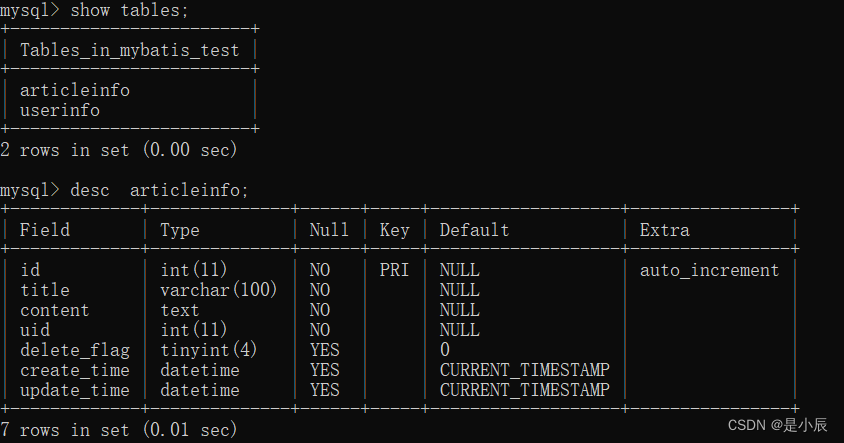
插入些数据:

Java对象:
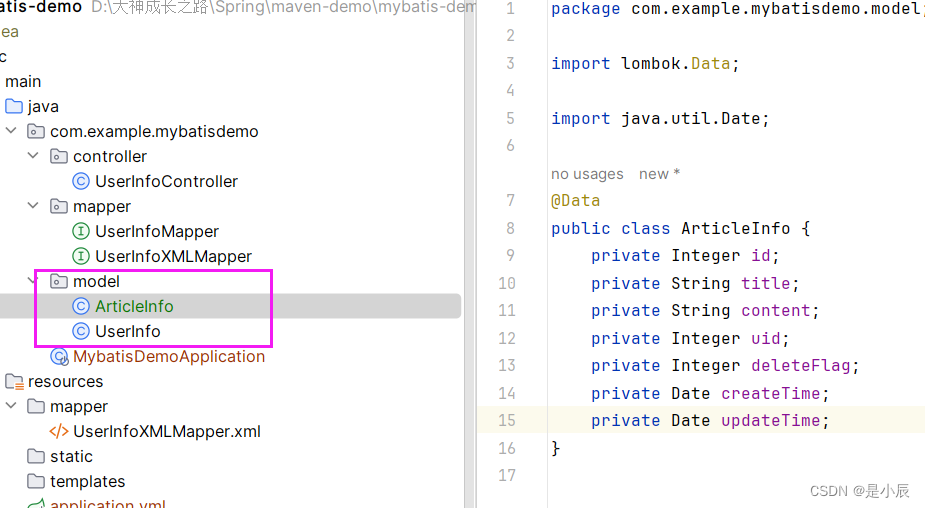
3.2 查询工作
查询id为1的作者的文章和作者信息。
SQL查询:mysql> select tu.username,tu.age,tu.gender, -> ta.title,ta.content -> from userinfo tu left join articleinfo ta on tu.id = ta.uid -> where tu.id = 1; +----------+-----+--------+----------+--------------+ | username | age | gender | title | content | +----------+-----+--------+----------+--------------+ | admin | 18 | 1 | Java | Java正文 | | admin | 18 | 1 | 数据结构 | 数据结构正文 | +----------+-----+--------+----------+--------------+ 2 rows in set (0.01 sec)- 1
- 2
- 3
- 4
- 5
- 6
- 7
- 8
- 9
- 10
- 11
但是要使用MyBatis查询,Java文章实体类中并没有用户的属性,所有必须要补充完整,补充完整如下:

定义接口:@Mapper public interface ArticleInfoMapper { @Select("select tu.username,tu.age,tu.gender," + "ta.title,ta.content " + "from userinfo tu right join articleinfo ta on tu.id = ta.uid " + "where ta.uid = #{id};") List<ArticleInfo> queryUserByUid(Integer id); }- 1
- 2
- 3
- 4
- 5
- 6
- 7
- 8
- 9
基本和单表相同,就是SQL语句不同,别名也可以正常使用。
-
相关阅读:
google-app:签名文件错误导致的上传失败
Webpack Bundle Analyzer包分析器
机器学习案例(十):新闻分类
在OpenWRT上自动重拨号获取公网IP(手记)
裸辞—躺平—刷题—大厂(Android面试的几大技巧)
Linux相关命令整理
windows故障转移集群磁盘扩容
Litestar 4D:统一眩光值计算
容器编排工具鉴赏- docker-compose 、Kubernetes、OpenShift、Docker Swarm
200+ML知识速查卡;『图解算法数据结构』配套代码;『剑指Offer』解题代码;『Python3』高频面试题目集;前沿论文 | ShowMeAI资讯日报
- 原文地址:https://blog.csdn.net/weixin_73392477/article/details/134441184
